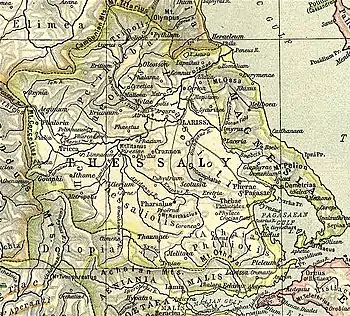Pythion
Pythion (Greek: Πύθιον) or Pythium, also Pythoion (Πύθοιον) was a city and polis (city-state)[1] of Perrhaebia in ancient Thessaly, situated at the foot of Mount Olympus, and forming a Tripolis with the two neighbouring towns of Azorus and Doliche. Pythion derived its name from a temple of Apollo Pythius situated on one of the summits of Olympus, as we learn from an epigram of Xeinagoras, a Greek mathematician, who measured the height of Olympus from these parts.[2] Games were also celebrated here in honour of Apollo.[3]

Geography
Pythion commanded an important pass across Mount Olympus. This pass and that of Tempe are the only two leading from Macedonia into the northeast of Thessaly.[4][5]
History
During the reign of Amyntas III or Philip II, the Tripolis was annexed to Macedon. According to Theagenes the inhabitants of Balla were relocated to Pythion. So we find in 3rd century BC an epigram regarding Philarchos son of Hellanion, Macedonian Elimiote from Pythion, proxenos in Delphi.[6][7]
During the Roman–Seleucid War, the Tripolis was ravaged by an army of Aetolians in the year 191 BCE[8] During the Third Macedonian War the three towns surrendered to the army of Perseus of Macedon in the year 171 BCE,[9] but that same year the Romans reconquered the three.[10] In the year 169 BCE troops arrived from the Roman consul Quintus Marcius Philippus who camped between Azorus and Doliche.[11][12]
The three cities minted a common coin with the inscription "ΤΡΙΠΟΛΙΤΑΝ".[13]
Although the site is occupied by a modern town of Pythio, virtually no remains of the ancient town have been discovered there.[14]
References
- Mogens Herman Hansen & Thomas Heine Nielsen (2004). "Thessaly and Adjacent Regions". An inventory of archaic and classical poleis. New York: Oxford University Press. pp. 726–727. ISBN 0-19-814099-1.
- ap. Plut. Aemil. Paul. 15.
- Stephanus of Byzantium. Ethnica. Vol. s.v. Πύθιον.
- Livy. Ab urbe condita Libri [History of Rome]. Vol. 42.53.
- Ptolemy. The Geography. Vol. 3.13.42.
- FD III 4:417
- City and sanctuary in ancient Greece: the Theorodokia in the Peloponnese By Paula Jean Perlman Page 127 ISBN 3-525-25218-8
- Livy. Ab urbe condita Libri [History of Rome]. Vol. 36.10.
- Livy. Ab urbe condita Libri [History of Rome]. Vol. 42.53.
- Livy. Ab urbe condita Libri [History of Rome]. Vol. 42.67.
- Polybius. The Histories. Vol. 28.13.1.
- Livy. Ab urbe condita Libri [History of Rome]. Vol. 44.2.
- Mogens Herman Hansen & Thomas Heine Nielsen (2004). "Thessaly and Adjacent Regions". An inventory of archaic and classical poleis. New York: Oxford University Press. pp. 721–722. ISBN 0-19-814099-1.
-
 Smith, William, ed. (1854–1857). "Pythium". Dictionary of Greek and Roman Geography. London: John Murray.
Smith, William, ed. (1854–1857). "Pythium". Dictionary of Greek and Roman Geography. London: John Murray.
 This article incorporates text from a publication now in the public domain: Smith, William, ed. (1854–1857). "Pythium". Dictionary of Greek and Roman Geography. London: John Murray.
This article incorporates text from a publication now in the public domain: Smith, William, ed. (1854–1857). "Pythium". Dictionary of Greek and Roman Geography. London: John Murray.